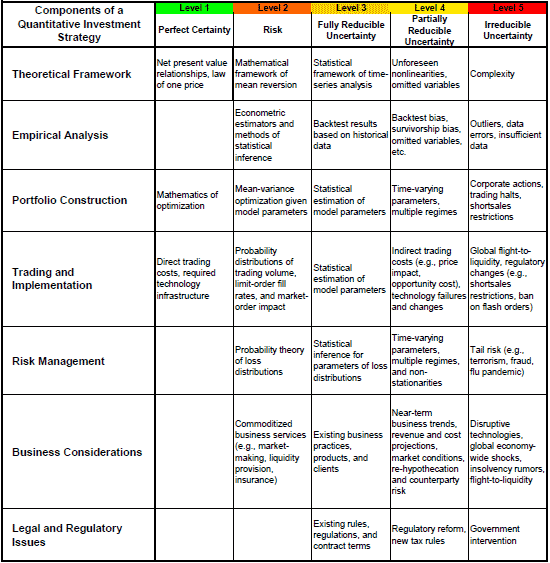How scientific can economics and finance be? In the March 2010 draft of their paper entitled “WARNING: Physics Envy May Be Hazardous To Your Wealth!”, Andrew Lo and Mark Mueller present a framework to help investors, portfolio managers, regulators and policymakers understand the potential effectiveness and inherent limitations of economics and finance. Focusing on levels of uncertainty (fully reducible, partially reducible, and irreducible) to explain some of the key differences between finance and physics and on the role of quantitative models in theory and practice, they conclude that:
- Quantitative models have difficulty incorporating expert intuition, while qualitative approaches often thwart testability, repeatability and scalability. Proprietary veils further hamper measurement of model costs and benefits.
- Economic systems are more complex and unstable than physical systems, undermining the viability of deduction based on a few fundamental principles. Economics and finance may be more like evolutionary biology, ecology and meteorology than physics.
- A dynamic economy or financial market, driven by natural selection of diverse/adaptive individual and institutional behaviors, implies an intricate taxonomy of uncertainty. Economic/financial relationships may simultaneously involve levels of uncertainty ranging from completely certain to irreducibly uncertain, and these levels can vary as technology evolves and understanding deepens. Failures of quantitative models in economics and finance nearly always derive from mismatches between levels of uncertainty and modeling methods.
- In using models with partially or completely irreducible uncertainties, investors must either: (1) develop a deeper understanding of what is going on; or, (2) admit ignorance and protect the portfolio by limiting the potential damage of the uncertainties (stop-losses, limits on capital commitments, statistical regime-switching and/or decision rules to trade off making a bet when the signal is wrong versus not making a bet when the signal is right).
- An investor should set the interval for investment/risk management decision making at least as short as the arrival interval for (uncertain) relevant information.
- A summary of the implications of different levels of uncertainty is a useful starting point for managing risk (see table below).
The following table, taken from the paper, identifies in columns different levels of potential economic/financial uncertainty and in rows components of the investing process, summarizing in cells the issues investors face. Issues in the upper left portion of the table require quantitative skills and tools, whereas issues in the lower right portion require experience and intuition. To be effective, risk management practices must address all the issues.

The authors add that:
“Faith in any person or organization claiming to have a deep and intuitive grasp of market opportunities and risks is no better or worse than putting the same faith and money behind a mysterious black-box strategy. What matters in each case is the transparency of the process, an opportunity to assess the plausibility and limitations of the ideas on which a strategy is based, clarity about expectations for risks as well as returns, an alignment of incentives between the investment manager and the investor, and proper accountability for successes and failures. Part of the recent distrust of quantitative models is that they are inanimate, and therefore inherently difficult to trust. Even when we manage to develop a certain level of comfort with a quantitative strategy, ongoing due diligence is needed to assess the consistency, integrity, and incentives of the human beings responsible for implementing the strategy.”
In summary, identifying and addressing appropriately the range of uncertainties found in financial markets is essential to investing success.